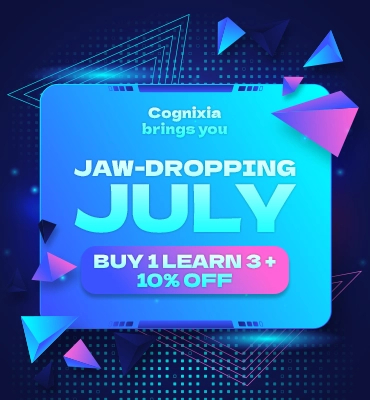Hello everybody and welcome back to the Cognixia podcast!
Every week, we bring to you some amazing new content about emerging technologies, hoping to help our listeners discover something they didn’t know before, help them in their careers, and inspire them to achieve their goals. Thank you for tuning in today, we are super excited about today’s episode. For today’s episode, we are going back to the basics. We have often found that we all get so engaged in the complex stuff, looking for the next big thing, the next big development, the next big invention, that we tend to forget how important the basics are. One of our listeners reached out to us recently, asking us this question after listening to one of our previous episodes, so we thought why not address it here today? Anu, if you are listening to us, this episode is dedicated to your question, thank you for reaching out. At Cognixia, we believe there is no such thing as a ‘stupid’ question and a lot of discoveries and inventions would not have happened if someone somewhere had not asked questions.
So, today’s episode is all about answering a very basic question – What is open source? We talk about open source, and we use open-source software, but what is open source really?
The simplest answer to this question would be open source is anything that has a design that is publicly accessible, so people can modify and share it freely. The term ‘open source’ in the specific context of software came around to represent the unique approach that was being used to create software programs. However, you might be surprised to know that the term ‘open source’ is not quite restricted to the world of software. Instead, it represents a very broad set of values – what is more popularly called ‘the open-source way’. The open-source way stands for open exchange, collaborative participation, rapid prototyping, transparency, meritocracy, and community-oriented development.
So, then how does software become open-source?
Well, simply put, open source software is software whose source code can be inspected, modified, and enhanced by anybody. Source code is the technical side of software that is not meant for the users to see, it dictates how software functions and what it does. It is usually the programmers who have access and visibility to the source code of any software, it is they who are responsible to ensure that the software performs the functions it is intended for, in the way it is designed, and eliminates any bugs that might be encountered. When this source code is not locked up behind limited access doors and is open to see & edit for everybody, that software is designated as open-source.
Now if you are wondering how is open source software different from other software, allow us to explain.
The opposite of open source software is closed-source software. Closed-source software is also called proprietary software. With proprietary software, only limited people have access to the source code – usually, it is just the original authors of the software who are legally permitted to copy, inspect, and change that software. The team or the organization holds tight and exclusive control over the software as well as its source code. When this proprietary software is made available to users, they usually have to sign a license and pay a fee by which they agree that they wouldn’t do anything to the software that they are not permitted to. For example, the Windows operating system, the Microsoft Office package, Adobe Acrobat, and Adobe Photoshop, all of these are proprietary software. If you remember, when you were installing it or sometimes even when you install an update, you are required to tick that little box that says you agree with all the terms and conditions, right? That’s where you signed for the license to use the software in a certain way and agree that anything outside of that would be a criminal offense.
However, this is not the case with open-source software. When open-source softwares is built, the makers keep the source code open and accessible to everybody. So, anybody can see the source code, copy it, change it, share it, inspect it, etc. You get the drift, right? For example, Linux and Kubernetes are open-source softwares. Now, if the source code is open, you would probably think then why do you still need to do that check-box thing about accepting the terms and conditions when you begin using the open-source softwares, right? Well, you are still using something somebody else has built, and it would not be too nice to ruin everything or corrupt the code or code in bugs and viruses into the software, right? There are unscrupulous elements everywhere, after all. So, yes, even when you begin using open-source software, you will still have to sign up for a license. However, the license agreement that you sign for using open-source softwares is markedly different from the one you sign for using proprietary software. The license agreement for open source software permits users to use open source software for any purpose.
Some open-source software also offers a copy-left license for users. A copy-left license is the opposite of a copyright. A copyleft license requires that any user who modifies the open source software in any way would also be required to release the source code for the same along with the program. Furthermore, some open-source licenses require that any user who alters and shares an open-source program with anybody would also be required to share the source code of the modified program without charging a licensing fee for it.

So, when using open-source software, it would be a good idea to check what the licensing agreement you signed up for stipulates. So, you can see that open-source softwares is designed to promote collaboration and sharing freely among the entire community without the typical borders and restrictions.
This begs the question, is open-source software beneficial and important only to programmers? What about the public at large? Is open-source software beneficial or important for people who are not programmers and just regular users?
Well, the idea of open-source is beneficial and important to everybody, irrespective of whether they are a programmer or not. If you rewind a bit and dig into the history of the internet, remember that the internet was built on the back of open-source software like the Linux operating system and the Apache Web Server application.
Why would one prefer using open-source software?
There are a few reasons we would say owing to which people prefer using open-source software.
First, open-source software offers control. One can always dig into the code to ensure that the program is functioning properly and delivering what they need. If you are not a programmer, you still benefit because it gives you the freedom to use the software however you deem fit, and not just in the way the programmers told you how to.
Second, it is a known fact that open-source softwares helps people become better programmers. As students or beginners open-source software gives one access to actual live code, while also allowing them to inspect it, better it, modify it and learn from it. Moreover, one can find bugs and mistakes in the code and learn from them.
Third, open-source softwares will usually be more stable and secure than proprietary software. This happens because anybody can view the code so anybody can spot bugs and anomalies. Most open-source softwares has large global communities behind them that are actively engaged in developing and improving the software. This also helps users at large as they get more secure and stable software to use. Open-source softwares follows open standards. Also, being open-source, the software won’t disappear if its original makers shut down or disappear or go bankrupt or some mishap happens. The software will continue to remain around and function as the community is still alive.
Fourth, an active community to support and promote the software. When we say community here, we don’t mean a fan club. An open-source software community is one that actively engages with the software, managing its code, adding more functionalities to it, keeping bugs in check, answering fellow user queries, helping each other, and growing together.
One misconception we would want to clear here is open-source software does not always mean free software. Open-source programmers do sometimes charge money for their open-source software. Sometimes, the programmers would charge users a fee for service and support instead of charging them for the software itself, even if it is all open-source. When this happens, the open-source softwares is still free of charge, but the programmers can make some money for helping users install, use, and troubleshoot it.
Also, a little secret tip for you. Organizations often tend to regard experience and skills in open-source programming a lot more than regular programming skills. Any experience with open-source programming is considered in very high stead by so many organizations. So, if you have some work experience on this front, make sure you make it shine on your resume. If you don’t, what more signs do you need, go get working now!
One of the most popular open-source softwares in the world right now is Kubernetes. It has this huge popularity all over the world, and Kubernetes skills are highly valuable and sought-after in the market right now. So, if you are looking for the next big thing for your career and this is a route that appeals to you, reach out to us today to know more about our Docker and Kubernetes training. The training covers everything you need to know to become a Certified Kubernetes Application Developer. Now that should be a gigantic leap for your career, shouldn’t it?
So, go on, reach out to us on our website or any of our social media handles, and our career development team will reach out to you and guide you.
With that, we come to an end to this week’s podcast episode. We hope you find it useful and liked listening to us. And if you did like it, maybe share it with your friends, colleagues, family, or anybody who would also find it useful. Until next week then, keep hustling and happy learning!

